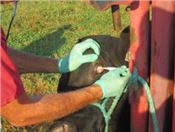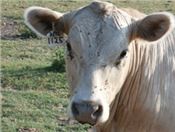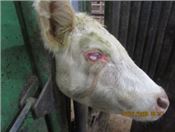Pinkeye Problems Cost Money
ELDON COLE
MT. VERNON, MO.
Pinkeye infection costs cow-calf and stocker raisers in southwest Missouri an untold amount of money each year. During the 2020 Monett Beef Conference, the panel of local veterinarians agreed the number one, profit-robbing disease in the area was pinkeye.
The problem arises because there are several causes of eye infections or physical injury that resemble pinkeye. The most common type of pinkeye is a strain called Moraxella bovis. More recently another strain, Moraxella bovoculi, is being cultured in the area. Other possible diseases that could mimic pinkeye are IBR and Mycoplasma infection.
To make matters worse, in addition to the infectious diseases mentioned above there are certain conditions that spread or contribute to eye irritations. Among those conditions are flies, especially face flies, dust, plant seeds, pollen and bright sunlight.
There are vaccines that may be used and most are targeted at Moraxella bovis. M. bovoculi strain is a relative newcomer to the vaccine list but has been cultured in herds around the area. A few veterinarians use autogenous vaccines and as you might suspect, the results have been mixed.
Most pinkeye vaccines require it be given a month ahead of pinkeye season followed with a booster in 3 to 4 weeks. An annual booster is recommended. A pinkeye implant is available for calves 3 months and older. A follow-up treatment is not necessary the first year but an annual booster is recommended. The cost of the vaccines vary from about $1.50 to $3.50 per head which is minor compared to potential economic losses.
Reports from our Missouri Steer Feedout, the Tri-County Steer Carcass Futurity and Iowa State University indicates weaning weights on affected calves average about 34 pounds lighter. In the finishing phase affected animals rack up a 34 pound loss per head compared to pen mates with normal eyes. During the most recent feedout we had 28 out of 101 head treated for eye infections. During the evaluation ahead of delivery of the current steers headed to Iowa the following comment was made. “On eyes, corporate feeders require them to have at least one good eye or they won’t take them and Nebraska guys want two good eyes.” The bad eye problem results in a big discount if the order buyer notices it.
It’s hard to tell how widespread eye problems will be this summer but there will be some. Plan now to be proactive, especially if you seem to have an annual problem. Vaccinate, booster, control flies, clip seedheads, treat affected animals promptly, consider patching eyes and consult with your veterinarian regarding treatment protocols.
Vaccination against pinkeye this spring should be considered. Again, talk it over with your veterinarian. Keep track of cattle who develop eye problems, even though the heritability is fairly low. The records could reveal something about your management.
Remember, an ounce of prevention is worth a pound of cure. ∆
ELDON COLE: Extension Livestock Specialist, University of Missouri

A veterinarian treating a bad case of pinkeye.

Face flies transmit pinkeye from animal to animal.

An advanced stage of pinkeye.